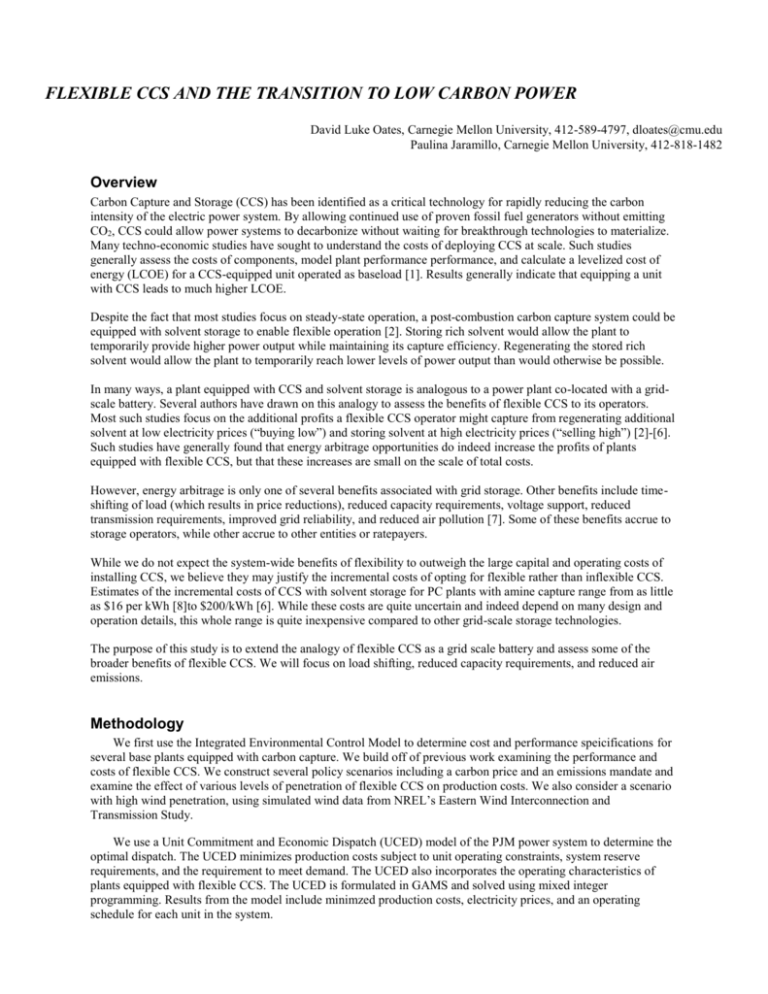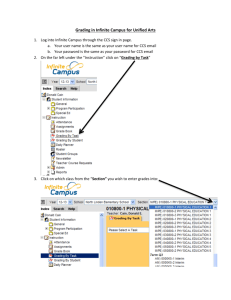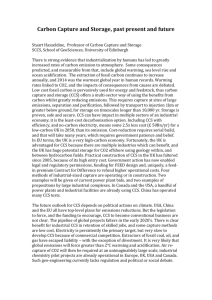View Extended Abstract - United States Association for Energy
advertisement

FLEXIBLE CCS AND THE TRANSITION TO LOW CARBON POWER David Luke Oates, Carnegie Mellon University, 412-589-4797, dloates@cmu.edu Paulina Jaramillo, Carnegie Mellon University, 412-818-1482 Overview Carbon Capture and Storage (CCS) has been identified as a critical technology for rapidly reducing the carbon intensity of the electric power system. By allowing continued use of proven fossil fuel generators without emitting CO2, CCS could allow power systems to decarbonize without waiting for breakthrough technologies to materialize. Many techno-economic studies have sought to understand the costs of deploying CCS at scale. Such studies generally assess the costs of components, model plant performance performance, and calculate a levelized cost of energy (LCOE) for a CCS-equipped unit operated as baseload [1]. Results generally indicate that equipping a unit with CCS leads to much higher LCOE. Despite the fact that most studies focus on steady-state operation, a post-combustion carbon capture system could be equipped with solvent storage to enable flexible operation [2]. Storing rich solvent would allow the plant to temporarily provide higher power output while maintaining its capture efficiency. Regenerating the stored rich solvent would allow the plant to temporarily reach lower levels of power output than would otherwise be possible. In many ways, a plant equipped with CCS and solvent storage is analogous to a power plant co-located with a gridscale battery. Several authors have drawn on this analogy to assess the benefits of flexible CCS to its operators. Most such studies focus on the additional profits a flexible CCS operator might capture from regenerating additional solvent at low electricity prices (“buying low”) and storing solvent at high electricity prices (“selling high”) [2]-[6]. Such studies have generally found that energy arbitrage opportunities do indeed increase the profits of plants equipped with flexible CCS, but that these increases are small on the scale of total costs. However, energy arbitrage is only one of several benefits associated with grid storage. Other benefits include timeshifting of load (which results in price reductions), reduced capacity requirements, voltage support, reduced transmission requirements, improved grid reliability, and reduced air pollution [7]. Some of these benefits accrue to storage operators, while other accrue to other entities or ratepayers. While we do not expect the system-wide benefits of flexibility to outweigh the large capital and operating costs of installing CCS, we believe they may justify the incremental costs of opting for flexible rather than inflexible CCS. Estimates of the incremental costs of CCS with solvent storage for PC plants with amine capture range from as little as $16 per kWh [8]to $200/kWh [6]. While these costs are quite uncertain and indeed depend on many design and operation details, this whole range is quite inexpensive compared to other grid-scale storage technologies. The purpose of this study is to extend the analogy of flexible CCS as a grid scale battery and assess some of the broader benefits of flexible CCS. We will focus on load shifting, reduced capacity requirements, and reduced air emissions. Methodology We first use the Integrated Environmental Control Model to determine cost and performance speicifications for several base plants equipped with carbon capture. We build off of previous work examining the performance and costs of flexible CCS. We construct several policy scenarios including a carbon price and an emissions mandate and examine the effect of various levels of penetration of flexible CCS on production costs. We also consider a scenario with high wind penetration, using simulated wind data from NREL’s Eastern Wind Interconnection and Transmission Study. We use a Unit Commitment and Economic Dispatch (UCED) model of the PJM power system to determine the optimal dispatch. The UCED minimizes production costs subject to unit operating constraints, system reserve requirements, and the requirement to meet demand. The UCED also incorporates the operating characteristics of plants equipped with flexible CCS. The UCED is formulated in GAMS and solved using mixed integer programming. Results from the model include minimzed production costs, electricity prices, and an operating schedule for each unit in the system. Results Figure 1 shows one week of operation of a coal plant equipped with flexible CCS in the preliminary results for our test system. In reality, this plant stores rich solvent during the day and regenerates additional rich solvent at night, corresponding to higher and lower than steady state power output, respectively. In the storage analogy, the overall plant is comprised of a conventional coal unit and a pseudo-battery. Overnight, the pseudo-battery is discharging, and overnight it is charging. The output of the overall plant is the sum of the output of the conventional coal unit plus the net discharge of the pseudo-battery. The state of charge of the pseudo-battery in Figure 1 B) looks like the charging pattern of a conventional battery. However, the net discharge of the pseudo-battery, in Figure 1 C) looks quite different. The charge and discharge limits are not constant and reflect the coupling with the coal unit in Figure 1 A). Due to the fact that the regenerator is only slightly larger than that required to maintain steady-state, the pseudo-storage is only capable of charging slightly when the coupled coal unit is generating full output. This asymmetry of charging and discharging distinguishes the flexible CCS pseudo-battery from conventional storage and will alter the load-shifting, capacity, and air emissions benefits of flexible CCS pseudo-batteries compared to conventional storage. Figure 1: Operation of a unit with flexible CCS in the plant+pseudo-battery analogy. A) Power output of the underlying coal plant. B) State of charge of the pseudo-battery showing diurnal charging pattern. C) Net discharge of the pseudobattery, showing coupling between output of underlying coal plant and net discharge limits. Note in particular on 06/07 that pseudo-storage cannot be charged or discharged when underlying plant is offline. Conclusions Transitioning to a low-carbon power system will likely require decommissioning of carbon intensive sources and the addition of variable renewable energy sources such as wind. Both capacity turnover and integration of renewables might be performed at reduced cost if more grid-scale storage were available. Due to its relatively small incremental cost, flexible CCS might be able to provide an alternative to traditional storage and achieve similar cost reductions. References [1] [2] [3] [4] [5] [6] [7] [8] R. E. NETL, “Cost and Performance Comparison Baseline for Fossil Energy Power Plants,” pp. 1–626, Nov. 2010. S. M. Cohen, G. T. Rochelle, and M. E. Webber, “Optimizing post-combustion CO2 capture in response to volatile electricity prices,” International Journal of Greenhouse Gas Control, vol. 8, pp. 180–195, May 2012. S. M. Cohen, G. T. Rochelle, and M. E. Webber, “Optimal operation of flexible post-combustion CO2 capture in response to volatile electricity prices,” Energy Procedia, vol. 4, no. C, pp. 2604–2611, 2011. H. Chalmers and J. Gibbins, “Initial evaluation of the impact of post-combustion capture of carbon dioxide on supercritical pulverised coal power plant part load performance,” Fuel, vol. 86, no. 14, pp. 2109–2123, Sep. 2007. D. Patiño-Echeverri and D. C. Hoppock, “Reducing the Energy Penalty Costs of Postcombustion CCS Systems with Amine-Storage,” Environ. Sci. Technol., vol. 46, no. 2, pp. 1243–1252, Jan. 2012. R. D. Brasington, “Integration and operation of post-combustion capture system on coal-fired power generation: load following and peak power,” Massachusetts Institute of Technology, 2012. J. Eyer and G. Corey, “Energy Storage for the Electricity Grid: Benefits and Market Potential Assessment Guide,” Sandia National Laboratories, Feb. 2010. H. Chalmers, M. Lucquiaud, J. Gibbins, and M. Leach, “Flexible operation of coal fired power plants with postcombustion capture of carbon dioxide,” Journal of Environmental Engineering, vol. 135, no. 6, pp. 449– 458, 2009.





